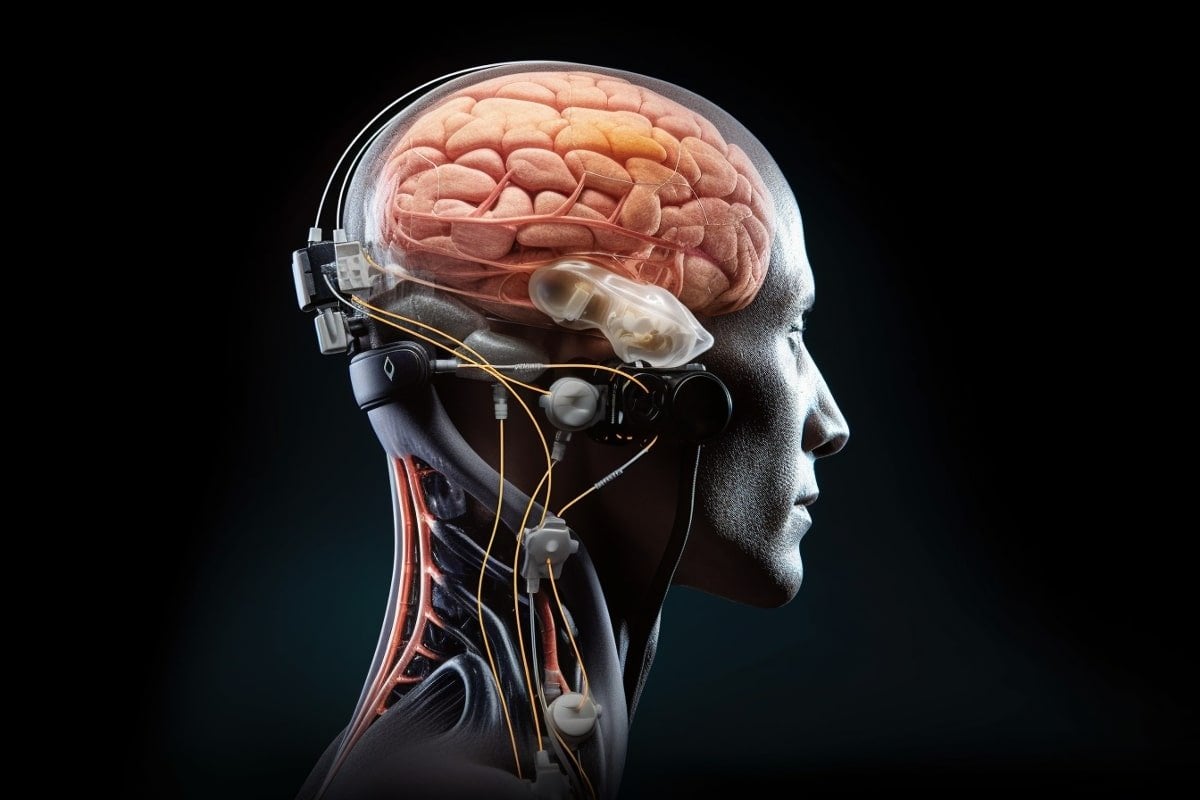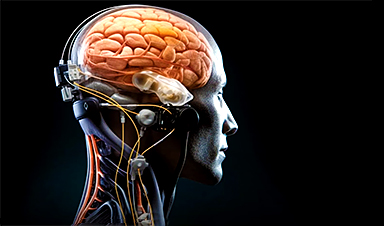Summary: In a pioneering study, researchers designed a wireless brain-spine interface enabling a paralyzed man to walk naturally again. The ‘digital bridge’ comprises two electronic implants — one on the brain and another on the spinal cord — that decode brain signals and stimulate the spinal cord to activate leg muscles.
Remarkably, the patient experienced significant recovery in sensory perceptions and motor skills, even when the interface was off. The team hopes to extend the technology’s applications to include restoring arm and hand functions, and assisting stroke patients.
Key Facts:
- The brain-spine interface is composed of two electronic implants that work together to decode brain signals and stimulate the spinal cord, resulting in the activation of leg muscles and enabling natural movement.
- The patient experienced significant improvement in sensory perceptions and motor skills, indicating potential development of new nerve connections even when the interface was not active.
- The team plans to explore applications of the technology to restore other functions and assist stroke patients, and there are ongoing efforts to commercialize the technology globally through ONWARD Medical, in partnership with CEA and EPFL.
Source: EPFL
Neuroscientists and neurosurgeons from EPFL/CHUV/UNIL and CEA/CHUGA/UGA report in the journal Nature that they have re-established the communication between the brain and spinal cord with a wireless digital bridge, allowing a paralyzed person to walk again naturally.
“We have created a wireless interface between the brain and the spinal cord using brain-computer interface (BCI) technology that transforms thought into action.”, summarizes Grégoire Courtine, Professor of Neuroscience at EPFL, CHUV and UNIL. Published in the journal Nature,
“Walking naturally after spinal cord injury using a brain-spine interface” presents the situation of Gert-Jan, 40 years old, who suffered a spinal cord injury following a bicycle accident that left him paralyzed.“The digital bridge enabled him to regain natural control over the movement of his paralyzed legs, allowing him to stand, walk, and even climb stairs. Gert-Jan explains that he has recovered the pleasure of being able to share a beer standing at a bar with friends : “This simple pleasure represents a significant change in my life”.
A digital bridge involving two electronic implants: one on the brain, the other on the spinal cord
To establish this digital bridge, two types of electronic implants are needed. Neurosurgeon Jocelyne Bloch, who is a professor at CHUV, UNIL and EPFL, explains: “We have implanted WIMAGINE® devices above the region of the brain that is responsible for controlling leg movements.
“These devices developed by the CEA allows to decode the electrical signals generated by the brain when we think about walking. We also positioned a neurostimulator connected to an electrode array over the region of the spinal cord that controls leg movement.
Guillaume Charvet, head of the BCI program at CEA, adds: “Thanks to algorithms based on adaptive artificial intelligence methods, movement intentions are decoded in real time from brain recordings.”
These intentions are then converted into sequences of electrical stimulation of the spinal cord, which in turn activate leg muscles to achieve the desired movement. This digital bridge operates wirelessly, allowing the patient to move around independently.
Recovery of neurological functions
Rehabilitation supported by the digital bridge enabled Gert-Jan to recover neurological functions that he had lost since his accident.
Researchers were able to quantify remarkable improvements in his sensory perceptions and motor skills, even when the digital bridge was switched off. This digital repair of the spinal cord suggests that new nerve connections have developed.

At this stage, the digital bridge has only been tested in one person. Jocelyne Bloch and Grégoire Courtine explain that, in the future, a comparable strategy could be used to restore arm and hand functions.
They add that the digital bridge could also be applied to other clinical indications, such as paralysis due to stroke.
The company ONWARD Medical, along with CEA and EPFL has received support from the European Commission trough its European Innovation Council (EIC) to develop a commercial version of the digital bridge, with the goal of making the technology available worldwide.
News
Studies detail high rates of long COVID among healthcare, dental workers
Researchers have estimated approximately 8% of Americas have ever experienced long COVID, or lasting symptoms, following an acute COVID-19 infection. Now two recent international studies suggest that the percentage is much higher among healthcare workers [...]
Melting Arctic Ice May Unleash Ancient Deadly Diseases, Scientists Warn
Melting Arctic ice increases human and animal interactions, raising the risk of infectious disease spread. Researchers urge early intervention and surveillance. Climate change is opening new pathways for the spread of infectious diseases such [...]
Scientists May Have Found a Secret Weapon To Stop Pancreatic Cancer Before It Starts
Researchers at Cold Spring Harbor Laboratory have found that blocking the FGFR2 and EGFR genes can stop early-stage pancreatic cancer from progressing, offering a promising path toward prevention. Pancreatic cancer is expected to become [...]
Breakthrough Drug Restores Vision: Researchers Successfully Reverse Retinal Damage
Blocking the PROX1 protein allowed KAIST researchers to regenerate damaged retinas and restore vision in mice. Vision is one of the most important human senses, yet more than 300 million people around the world are at [...]
Differentiating cancerous and healthy cells through motion analysis
Researchers from Tokyo Metropolitan University have found that the motion of unlabeled cells can be used to tell whether they are cancerous or healthy. They observed malignant fibrosarcoma [...]
This Tiny Cellular Gate Could Be the Key to Curing Cancer – And Regrowing Hair
After more than five decades of mystery, scientists have finally unveiled the detailed structure and function of a long-theorized molecular machine in our mitochondria — the mitochondrial pyruvate carrier. This microscopic gatekeeper controls how [...]
Unlocking Vision’s Secrets: Researchers Reveal 3D Structure of Key Eye Protein
Researchers have uncovered the 3D structure of RBP3, a key protein in vision, revealing how it transports retinoids and fatty acids and how its dysfunction may lead to retinal diseases. Proteins play a critical [...]
5 Key Facts About Nanoplastics and How They Affect the Human Body
Nanoplastics are typically defined as plastic particles smaller than 1000 nanometers. These particles are increasingly being detected in human tissues: they can bypass biological barriers, accumulate in organs, and may influence health in ways [...]
Measles Is Back: Doctors Warn of Dangerous Surge Across the U.S.
Parents are encouraged to contact their pediatrician if their child has been exposed to measles or is showing symptoms. Pediatric infectious disease experts are emphasizing the critical importance of measles vaccination, as the highly [...]
AI at the Speed of Light: How Silicon Photonics Are Reinventing Hardware
A cutting-edge AI acceleration platform powered by light rather than electricity could revolutionize how AI is trained and deployed. Using photonic integrated circuits made from advanced III-V semiconductors, researchers have developed a system that vastly [...]
A Grain of Brain, 523 Million Synapses, Most Complicated Neuroscience Experiment Ever Attempted
A team of over 150 scientists has achieved what once seemed impossible: a complete wiring and activity map of a tiny section of a mammalian brain. This feat, part of the MICrONS Project, rivals [...]
The Secret “Radar” Bacteria Use To Outsmart Their Enemies
A chemical radar allows bacteria to sense and eliminate predators. Investigating how microorganisms communicate deepens our understanding of the complex ecological interactions that shape our environment is an area of key focus for the [...]
Psychologists explore ethical issues associated with human-AI relationships
It's becoming increasingly commonplace for people to develop intimate, long-term relationships with artificial intelligence (AI) technologies. At their extreme, people have "married" their AI companions in non-legally binding ceremonies, and at least two people [...]
When You Lose Weight, Where Does It Actually Go?
Most health professionals lack a clear understanding of how body fat is lost, often subscribing to misconceptions like fat converting to energy or muscle. The truth is, fat is actually broken down into carbon [...]
How Everyday Plastics Quietly Turn Into DNA-Damaging Nanoparticles
The same unique structure that makes plastic so versatile also makes it susceptible to breaking down into harmful micro- and nanoscale particles. The world is saturated with trillions of microscopic and nanoscopic plastic particles, some smaller [...]
AI Outperforms Physicians in Real-World Urgent Care Decisions, Study Finds
The study, conducted at the virtual urgent care clinic Cedars-Sinai Connect in LA, compared recommendations given in about 500 visits of adult patients with relatively common symptoms – respiratory, urinary, eye, vaginal and dental. [...]





















